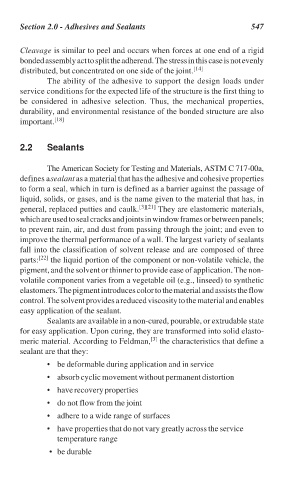Page 577 - Handbook of Thermal Analysis of Construction Materials
P. 577
Section 2.0 - Adhesives and Sealants 547
Cleavage is similar to peel and occurs when forces at one end of a rigid
bonded assembly act to split the adherend. The stress in this case is not evenly
distributed, but concentrated on one side of the joint. [14]
The ability of the adhesive to support the design loads under
service conditions for the expected life of the structure is the first thing to
be considered in adhesive selection. Thus, the mechanical properties,
durability, and environmental resistance of the bonded structure are also
important. [18]
2.2 Sealants
The American Society for Testing and Materials, ASTM C 717-00a,
defines a sealant as a material that has the adhesive and cohesive properties
to form a seal, which in turn is defined as a barrier against the passage of
liquid, solids, or gases, and is the name given to the material that has, in
general, replaced putties and caulk. [3][21] They are elastomeric materials,
which are used to seal cracks and joints in window frames or between panels;
to prevent rain, air, and dust from passing through the joint; and even to
improve the thermal performance of a wall. The largest variety of sealants
fall into the classification of solvent release and are composed of three
parts: [22] the liquid portion of the component or non-volatile vehicle, the
pigment, and the solvent or thinner to provide ease of application. The non-
volatile component varies from a vegetable oil (e.g., linseed) to synthetic
elastomers. The pigment introduces color to the material and assists the flow
control. The solvent provides a reduced viscosity to the material and enables
easy application of the sealant.
Sealants are available in a non-cured, pourable, or extrudable state
for easy application. Upon curing, they are transformed into solid elasto-
[3]
meric material. According to Feldman, the characteristics that define a
sealant are that they:
• be deformable during application and in service
• absorb cyclic movement without permanent distortion
• have recovery properties
• do not flow from the joint
• adhere to a wide range of surfaces
• have properties that do not vary greatly across the service
temperature range
• be durable

